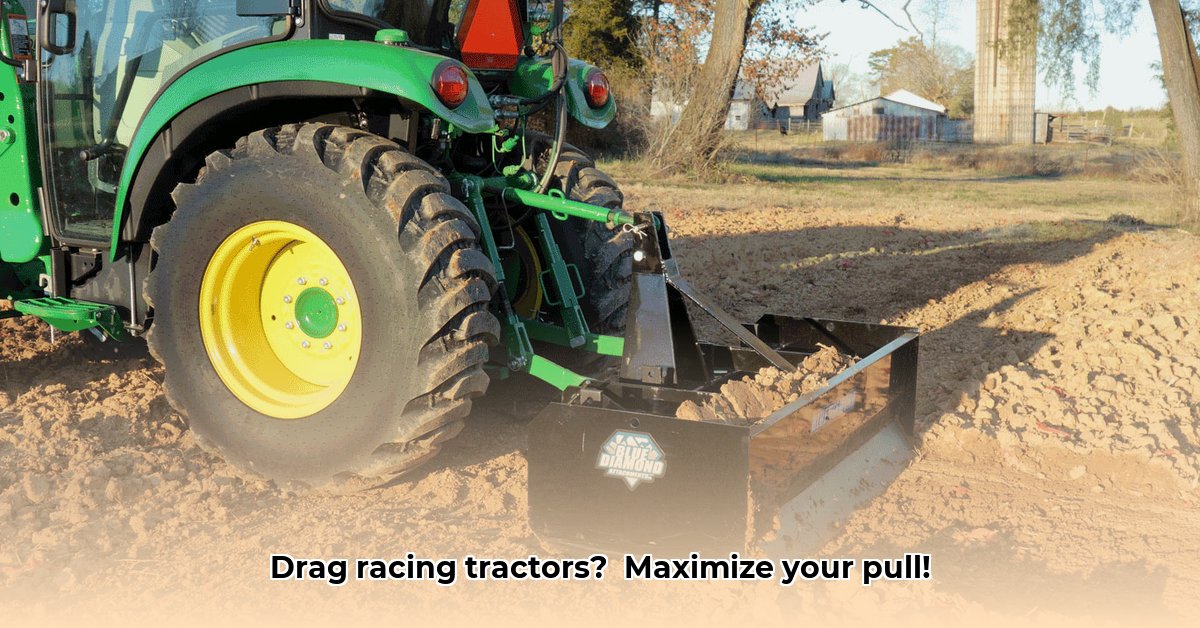
Tractor Drag Box: Your Guide to Increased Efficiency
Tractor drag boxes, also known as box blades or box scrapers, are versatile implements offering significant benefits for sustainable agriculture. This comprehensive guide explores their uses, selection, operation, and maintenance, empowering you to maximize their potential on your farm. For more on tractor implements, check out this helpful resource.
What is a Tractor Drag Box?
A tractor drag box is a sturdy metal box attached to your tractor's three-point hitch (the system connecting implements to the back of a tractor). It features adjustable blades at the front and back, allowing precise control over ground interaction. These blades can be angled, tilted, and adjusted for depth, providing remarkable versatility. Its simple design belies its impressive capabilities.
Versatility Unleashed: Applications of a Tractor Drag Box
The true value of a tractor drag box lies in its adaptability. It excels in a wide range of tasks, contributing to efficient and sustainable farming practices.
- Precise Land Leveling: Creates a perfectly smooth surface for planting, maximizing seed-to-soil contact and ensuring even crop growth. This can improve yields.
- Road and Driveway Construction/Maintenance: Simplifies the construction and repair of farm roads and driveways, eliminating the need for external contractors.
- Material Handling: Efficiently moves and spreads materials like dirt, gravel, mulch, and manure, streamlining your workflow.
- Improved Soil Drainage: Creates ditches and improves water flow, preventing waterlogging and promoting healthier plant growth. This reduces erosion.
- Soil Aeration and Smoothing: Breaks up compacted soil, improving root penetration and nutrient uptake. This leads to healthier soil. Does this improve yields, Dr. Smith?
Picking the Perfect Tractor Drag Box: A Buyer's Guide
Selecting the right drag box is vital for optimal performance and longevity. Consider these factors:
- Tractor Compatibility: The box blade's weight and size must match your tractor's horsepower and lifting capacity. Consult your tractor's manual.
- Size and Width: Wider blades cover more ground but require more power. Choose a size appropriate for your projects.
- Blade Material: High-quality hardened steel ensures durability and a longer lifespan.
- Blade Adjustability: Adjustable blades (that can change angle and tilt) increase versatility for diverse tasks and terrain.
- Ripper Shanks (optional): These attachments enhance soil aeration, particularly beneficial in compacted soils.
- Hitch Type: Ensure compatibility with your tractor's three-point hitch system.
Mastering Your Tractor Drag Box: A Step-by-Step Guide
Effective and safe operation requires a methodical approach:
- Secure Attachment: Carefully attach the box blade to your tractor's three-point hitch, verifying all connections.
- Blade Adjustment: Set blade angle and depth for the specific task. Start shallow and gradually increase.
- Gentle Start: Begin slowly to assess the drag box's interaction with the soil.
- Consistent Speed: Maintain a consistent speed for even grading and to prevent damage.
- Overlapping Passes: Overlap passes slightly for uniform coverage, especially during leveling.
- Regular Inspection: Regularly inspect for damage or wear. Clean debris after each use.
Maintaining Your Investment: Simple Steps for Long Life
Regular maintenance extends the lifespan and effectiveness of your drag box:
- Post-Use Cleaning: Thoroughly clean the box blade after each use to remove mud, debris, and stones.
- Lubrication: Keep moving parts lubricated according to the manufacturer's recommendations.
- Blade Inspection: Periodically check blades for wear and replace damaged or excessively worn blades.
- Bolt Tightness: Regularly check the tightness of all bolts and fasteners.
Weighing the Pros and Cons: Is a Tractor Drag Box Right for You?
Advantages:
- Exceptional Versatility: Handles various tasks, minimizing the need for specialized equipment.
- Increased Efficiency: Streamlines land preparation and material movement.
- Improved Soil Health: Promotes better soil structure, aeration, and drainage.
- Cost Savings (Long-Term): Reduces labor costs and increases efficiency.
Potential Drawbacks:
- Upfront Cost: Can be a significant initial investment.
- Maintenance Costs: Requires regular maintenance and occasional repairs.
- Tractor Requirements: Needs a tractor with sufficient horsepower and a three-point hitch.
A tractor drag box is a valuable asset for many farms, boosting productivity and contributing to sustainable agriculture. However, consider individual needs, budget, and tractor capabilities.
How to Improve Soil Health Using Sustainable Agricultural Practices
Key Takeaways:
- Minimizing soil disturbance improves soil structure and reduces erosion.
- Maximizing soil cover enhances water infiltration and nutrient retention.
- Enhancing soil biodiversity boosts nutrient cycling and overall soil health.
- A tractor drag box is a valuable tool for achieving these goals through efficient land preparation. Isn't optimizing soil health a critical aspect of modern farming? Many farmers are now focusing on this as a key performance indicator, aren't they?
Using Your Drag Box for Sustainable Soil Management
- Assess Your Soil: Understanding your soil type informs blade settings and passes.
- Choose the Right Settings: Different depths and angles yield different results.
- Work in Small Sections: This ensures more consistent results and prevents compaction.
- Maintain the Box Blade: Regular maintenance prevents damage and ensures optimal performance. This is vital—a well-maintained box blade will give you years of reliable service.